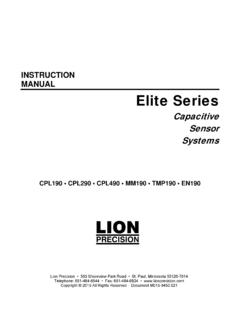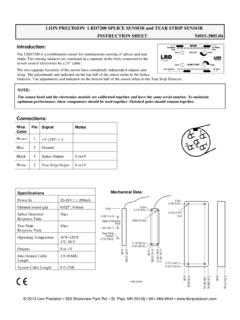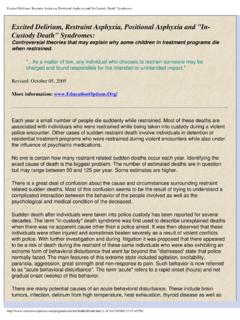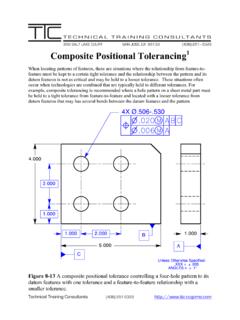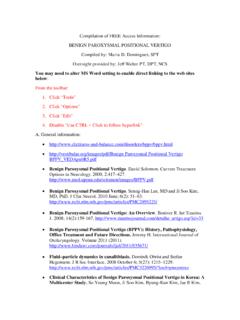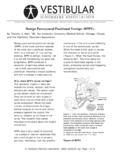Transcription of Spindle Runout Effects on Positional Accuracy - …
1 Spindle Runout Effects on Positional Accuracy As presented at the University of Wisconsin Symposium on Small Hole Technology'. February 22, 1990. Palm Springs, California Authors: Don L. Martin Robin O. Wilcox Lion Precision Minneapolis, Minnesota Spindle Runout Effects on Positional Accuracy Improving drilled hole quality is a continuous process within the printed circuit board industry. The emphasis on small hole and microhole drilling has led management to further study the parameters which can affect quality. One area of growing interest is Spindle /collet Runout and its affect on hole registration. It has been suspected that Spindle and collet Runout contribute to hole quality but there has never been any confirmation of this belief. In the past, the tools available to the drilling department did not allow personnel to analyze Runout and take corrective action if needed. Rather, the typical Runout test involved a dial indicator positioned against a gage pin, with the Spindle manually rotated.
2 Interpretation of the results was difficult and open to operator variability. Because of these limitations, and because a concrete connection between Runout and hole quality concerns such as misregistration has never been made, drill room management typically has not closely monitored Spindle /collet Runout . Although some facilities check Runout daily with the dial indicator, decisions are still primarily made as a result of trial and error rather than quantitative analysis. The use of the Lion Precision Dynamic Runout System has changed the situation, allowing the drilling department to accurately monitor Spindle /collet Runout at operating speeds on the drilling machine. As a result, new questions are being asked. These questions were not asked before, not because of a lack of interest, but because there was no easy way to get the answers. One topic of interest is the suspected impact of excessive Runout on hole registration.
3 The purpose of this paper is to present a study completed at several printed circuit companies which evaluated the impact of Runout on registration. Study Design The study was completed in December and January, 1989 and 1990, at two printed circuit board facilities in Minneapolis, Minnesota. Four different hole sizes were studied by first drilling the holes and then inspecting for hole registration. The ideal hole center and standard deviation of the actual holes was then calculated. Drill Bit Sizes Drill Machines .045 inch Excellon Automation Mark V..0225 inch. Ball Bearing Spindle .018 inch Excellon Automation Mark V Stretch .0135 inch Westwind Air Bearing + Drill bits supplied by Tycom Inspection Equipment Excellon Opic III Inspection Station View Engineering Pr cis 3000. Measurement Equipment lion Precision Dynamic Runout System WBBI Transducer Holder for Spindle mounting Panel Construction Part 1: 112 ounce Copper, FR4, 6 layer, 3 high Part 2: 112 ounce Copper, FR4 2116,8 layer, 3 high The first part of the study used actual production panels with.
4 045 and .0225 inch drill bits, using ball bearing spindles. Inspection was completed on the pit 1~ inspection station. Repeatability studies done by the authors of the study suggest operator error when the Opic Ill was used. As will be seen below, the results of this part of the study were somewhat inconclusive, in part because of registration measurement problems. Further study was completed on 018 and .0135 inch holes, this time using a test pattern drilled with air bearing spindles. These holes were then inspected using automatic inspection station. The results found in this second part of the study are more reliable than the first part, because of the use of the automatic inspection station( Accuracy better than +/ .0002 inches). Total lndicated Reading TIR is a measurement of the variation from the ideal path a Spindle /collet system will follow when turning. It is defined as the difference between the closest and farthest away point the target surface travels, admeasured from a reference point (please see Figure 1).
5 TOTAL INDICATED READING (TIR). Difference between the most minimum and most maximum value TIR. Typical Spindle /Collet Top View Figure 1. The Lion Precision Dynamic Runout System uses capacitance technology to measure TIR. The device monitors the position of target surface (in this case the gage pin surface) as the gage pin revolves. The difference between the minimum and maximum positions, or Runout , is then displayed The analog signal of the position is also available for output to an oscilloscope or other analytical device. The advanced circuitry design provides for high frequency response, allowing accurate measurement at speeds of over120,000 rpm, down to 0 rpm. Larger Hole Study Larger Hole Study portion of the study was completed on .057 inches thick pane/s, 6 layers, FR4 clad with 1/2 ounce copper. The panels were drilled three high. The feed rate for the 045. inch hole was I 16 inches per minutest 49,000 rpm, for the.
6 0225 inch hole 80 inches per minute at 80,000 rpm. No strong correlation between high Runout and misregistration was seen on these panels. The standard deviation between low Runout and high Runout was essentially the same, from .0003 to .0006 inch (one sigma), depending upon the hole size and speed of drilling. These results suggest two possible conclusions, that 1) either Runout is not a significant contributor to hole misregistration at larger holes sizes or 2)the operator error using the Opic III caused the data to be unusable. Repeatability studies done by the authors of the study found low repeatability. The authors were not skilled in the use of the equipment and, because of a time constraint, training was minimal. While it is believed the registration data has some problems with it, data gathered in the second part of the study suggests Runout does not have a large effect on registration at larger hole sizes. Runout and registration information was collected for eleven days.
7 For most of those days, Runout was checked at the beginning of the first shift, after collet cleaning. An interesting lack of consistency' can be seen in Figure 2 for each of the four ball bearing spindles monitored: a). Runout was monitored at three different speeds. Regardless of the speed, the Runout variation from day to day was rather dramatic, with the changes apparently random. 6). Although the higher speeds generally had higher Runout than the lower speeds for any one Spindle , this was not always the case. Occasionally Runout at higher speeds was actually lower than at lower speeds. For example, in Figure 2, Spindle 3, the Runout at 80,000 rpm was lower than the Runout at 49,000 rpm on several days. The same operator completed the Runout monitoring each day after collet cleaning. The variation seen between the daily readings suggests other forces are at work besides operator variability. These results on ball bearing spindles are consistent with results seen in the field, both by Lion Precision and by customers.
8 Runout Over Time Figure 2. Figure 2. Small Hole Runout The second part of the study was completed during one four hour period. The panels were approximately .060 inch thick, 8 layers, with FR4 2116 glass, I ounce copper inner layers and 1/2 ounce copper outer layers. The panels were drilled three high, using a test grid, at 80,000. rpm. Drill bit sizes were .018 inches. Two different collets were used, with small Runout and large Runout , for comparison purposes. Runout measurements are seen in Figure 3: Runout Measurements Speed Small Runout Large Runout 0 rpm .0002* inch .0015* inch 20,000 rpm .000109 inch .001476 inch 40,000 rpm .000103 inch .001520 inch 60,000 rpm .000123 inch .001607 inch 80,000 rpm .000167 inch .001712 inch 100,000 rpm .000221 inch .001790 inch *Measured using dial indicator Figure 3. Study Results Range The X and Y coordinate Range information can be found in Appendix B. Figures 4 and 5. summarize the data.
9 Figure 4 Figure 5. The following conclusions can be made: The X Range gets larger as the drill bit proceeds through the three panels, with the largest range occurring on the bottom surface of the third panel. The same is true of the Y Range; that is, the range grows as the drill bit proceeds through the panels. The Y Range is generally higher than the X Range, which is expected since in this study the Y coordinate reflects the impact of table movement as well as the impact of Runout . The X coordinate Range of the .0135 inch holes drilled under the large Runout condition was about twice as large as the Range of the same size drilled hole with small Runout . The X coordinate Range of the .018 inch holes drilled under the large Runout condition was 10 to 50 % larger than the X Range of the "small Runout holes. Study Results - Standard Deviation Figures 6 and 7 summarize the 3 sigma results for the ,018 and . inch. Figure 6 Figure 7.
10 Figure 8 presents the data collected from the top panel, comparing the large and small . Runout hole center variation. Figure 9 is a similar graph, but compares data from the top of the first panel compared to the bottom of the third panel. The wander of the drill bit through the various panel layers can be seen. The following conclusions about the hole center locations can be drawn: The total standard deviation of the large Runout .035 inch drilled holes is about 100 %. larger than the small Runout holes. This is consistent throughout the layers, no matter what the position of the panel (bottom or top). The total standard deviation of the large Runout .018 inch drilled holes is 25 to 50 %. larger than that of the small Runout holes. The total standard deviation does get larger as the drill bit proceeds through the layers, with the deviation of the top layer for the .0135 inch hole increasing over three times by the bottom of the third layer: The total standard deviation also grows for the.


